If you live, work or play on N.E. Alberta Street, you are invited to vote for one of three finalists in the Umpqua Bank's Build Your Block program. Umpqua Bank will help make the winning project a reality with a grant of up to $10,000 and support from bank staff.
The three ideas picked as finalists are: "The Back to the Roots Community Garden," suggested by Mardica Hicks of the Community Children's Clinic; 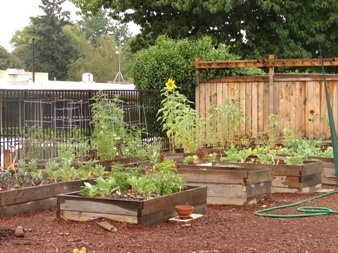 the Youth Driven Community Art Project, suggested by Angela Molloy Murphy of Rowanberry School, and the Vertical Garden, suggested by Helen Silvis, of The Skanner News. (Full disclosure: "Yes that's me.")
the Youth Driven Community Art Project, suggested by Angela Molloy Murphy of Rowanberry School, and the Vertical Garden, suggested by Helen Silvis, of The Skanner News. (Full disclosure: "Yes that's me.")
Voting will run from now until the extended deadline of September 24. Drop into the Umpqua Bank at 1745 N.E. Alberta to cast your vote. The winner will be announced on facebook and here at The Skanner news.
So what is the Build Your Block program about, and what would each of the projects offer North and Northeast Portland?
Robin Shuey of Umpqua Bank, says Build Your Block is a way for the bank – which opened shop on Alberta Street last month -- to connect to the North and Northeast Portland community. "The concept behind it is we are looking for a new way to come into a new community," Shuey said. "And we wanted to hear what the neighborhood has to say about the improvements they want to see."
The bank asked for project ideas on its facebook page, then narrowed the field to the final three. The winning project will be funded with up to $10,000 – administered by bank employees. Here are the final three ideas:
1. The Back to the Roots Community Garden
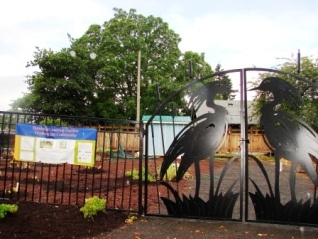 As a community health practitioner who works with children – with and without insurance -- Mardica Hicks is a passionate advocate for children.
As a community health practitioner who works with children – with and without insurance -- Mardica Hicks is a passionate advocate for children.
"We see far too many kids set up for a lifetime of chronic disease bcause they haven't had access to a healthy lifestyle and that includes good food," Hicks says. "For me children's health is premier – that's key – and nothing is more fundamental than what we put into our mouths."
That was the inspiration behind the "Back to the Roots Community Garden, which is partnering with Humboldt School, and the nonprofits Twysted Healing Systahs and the Healing Roots Center to create a community learning garden on a fallow lot at the school.
Children will learn to grow vegetables and fruit at the garden. They'll get that great feeling that comes from putting your hands into the earth and planting and growing your own food, said Hicks, who runs the Children's Community Clinic on N. Killingsworth Street. "There is a certain amount of emotional nurturing that comes from gardening – watching the vegetable grow and seeing that success. You planted that and it's now living and thriving.
"I believe in getting kids involved in their own health maintenance program and healthy eating is a part of that – and that option is not available to many children in our community."
Hicks invites the community to get involved with the garden. With the Umpqua grant, the garden would be able to buy plants and seeds and pay a small amount to a project and community organizer, who could reach out to volunteers and the community and help move the project forward. The principal of Humboldt school is writing a curriculum for the garden. In the future, Hicks says, the plan is to create a farmers market and sell the surplus fruit and vegetables.
"We want to create our own farmer's market that's really available at the times our community needs, and has the kinds of fruits and vegetables that our community would like to have."
2. The Youth Driven Community Art Project
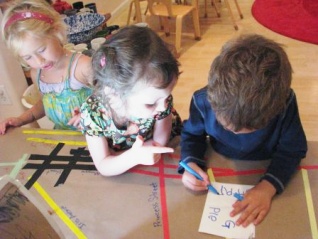 Angela Molloy Murphy the owner of Rowanberry School, on N. Mallory Street at Dekum, believes that pre-school children have a thing or two to tell us about art and life. The school models itself on schools in the Reggio Emilia province of Italy. The idea is that even very young children are capable and intelligent.
Angela Molloy Murphy the owner of Rowanberry School, on N. Mallory Street at Dekum, believes that pre-school children have a thing or two to tell us about art and life. The school models itself on schools in the Reggio Emilia province of Italy. The idea is that even very young children are capable and intelligent.
"Our job is drawing out the possibilities they already have, rather than filling them up," Murphy says.
The project would ask preschoolers from Rowanberry, and other similar preschools in the neighborhood that already work together, to look at art on and around Alberta Street and then express their ideas about it.
"We might take them to Alberta and look at the art there, and show them some murals," Murphy said. "Then we would talk about it. We might give them a phrase such as: Art Gives Your Heart a Voice, and ask them what that would look like to them."
Artists who already work with the children at several of the schools would help them express their ideas through their own art.
The children's art – pictures and words -- would then be displayed on a large—scale format using weatherproof vertical banners that would hang in prominent places at various locations around North and Northeast Portland. 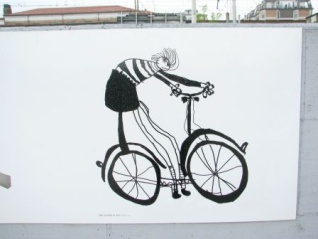
"We'd put them on and around Alberta Street and the Woodlawn triangle would be another good place. There's a lot of space there and not much beauty – yet," Murphy said.
Murphy believes the children's art would astound us with its beauty and depth.
"Part of this is to raise people's image of the young child," she said. "as well as to adorn the neighborhood with something inspiring and uplifting."
3. The Vertical Garden.
As a writer for The Skanner, this reporter usually prefers to keep the focus on other people's ideas. But I added the garden idea to the list on the spur of the moment, after seeing the Vertical Garden Institute's website. 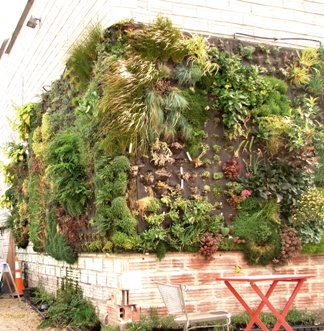 The idea is to make plain city walls and spaces beautiful, by adding a designed covering of plants and flowers. The Skanner News Video:Vertical Gardens
The idea is to make plain city walls and spaces beautiful, by adding a designed covering of plants and flowers. The Skanner News Video:Vertical Gardens
Vertical gardens are doing just that in cities such as Paris, Madrid and Tacoma. Botanist Patrick Blanc is the artist behind many of these projects. In the Northwest, Phil Yates recently founded the Vertical Garden Institute, to promote the idea and make our cities more beautiful.
"There are too many ugly walls," Yates says. "And think of all the ugly chain-link fences. There are hundreds and hundreds of plants you can use and you can do this in a very sustainable way. But I don't think you can do this on the basis of sustainability – you have to do it on the basis of beauty and art."
Yates has been working with Sky Rousse, an artist and a gardener who lives in the Alberta neighborhood, to learn more about the best way to create the gardens. Made of layers of a felt-like material hung over a PVC backdrop, the gardens are very light because you don't need soil to grow them. You do need a drip watering system to add food and water – especially in the hottest months.
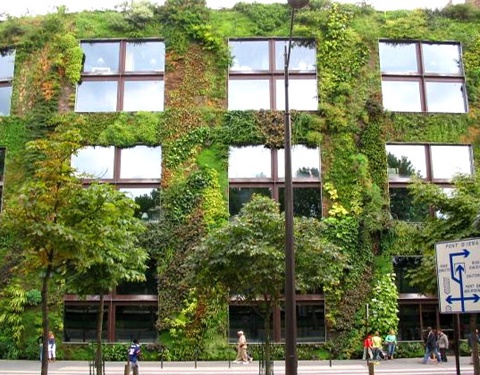 The Vertical Garden project would partner with the institute, and an as-yet-unidentified building owner in the North Northeast neighborhood. All interested community members are invited to create a garden to cover a wall in the neighborhood. Building owners are invited to apply to host the garden. Ideally a neighborhood school would be involved so students could learn how to make the gardens.
The Vertical Garden project would partner with the institute, and an as-yet-unidentified building owner in the North Northeast neighborhood. All interested community members are invited to create a garden to cover a wall in the neighborhood. Building owners are invited to apply to host the garden. Ideally a neighborhood school would be involved so students could learn how to make the gardens.
PHOTOS From Top: The Back to the Roots Garden at Humboldt School; Gates of the Back to the Roots garden; Children from the Rowanberry School making art; Mural of bicycle and rider by children at the Rowanberry School; The experimental vertical garden at the Vertical Garden Institute in Oregon City; A vertical garden by Patrick Blanc at Les Halles in Paris.












































































































































































































































































































